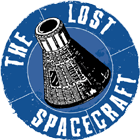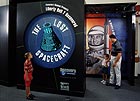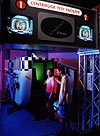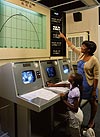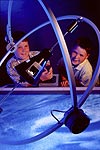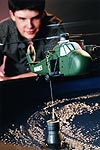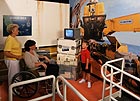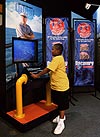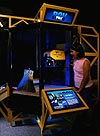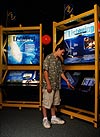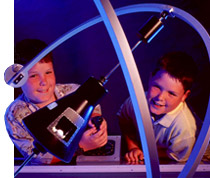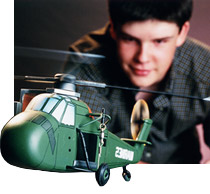The Lost Spacecraft: Liberty Bell 7 logo
THE LOST SPACECRAFT: Liberty Bell 7 Recovered
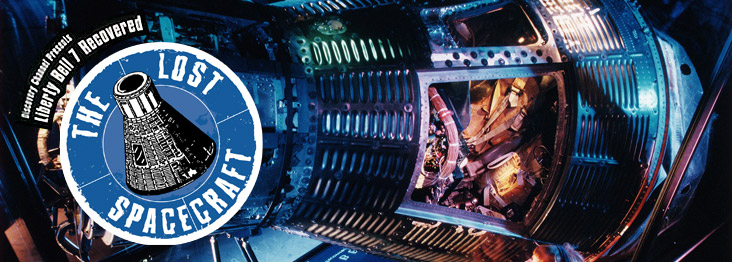
1. Entrance to exhibit
Museum visitors across the nation are seeing the Liberty Bell 7 spacecraft in “The Lost Spacecraft: Liberty Bell 7 Recovered” for the first time since the capsule’s loss in 1961. The blockbuster interactive exhibit highlights the history and technology, human dedication and triumph surrounding Liberty Bell 7 and its pilot, U.S. Air Force Capt. Virgil “Gus” Grissom.
2. 1961 living room
A family living room circa 1961, just like the ones in which millions of Americans sat riveted to their televisions as astronauts rocketed into space, welcomes visitors as they enter the blockbuster exhibit, “The Lost Spacecraft: Liberty Bell 7 Recovered.” Museum-goers experience the sights and sounds of the Cold War era in which the United States competed with the Soviet Union in a race to the moon, contrasted with state-of-the-art technology that in 1999 enabled explorers to raise the capsule.
3. Centrifuge test facility
At “The Lost Spacecraft: Liberty Bell 7 Recovered,” visitors get a hands-on physics lesson on the effects of gravity. Some patrons may climb into a two-person pod and experience up to two G forces in a simulator for centrifuge training, much like the astronauts of the early space program used.
4. Capsule Simulator
The Mercury Program resolved to put a manned spacecraft into the earth’s orbit and to investigate a human’s ability to survive and work in space. In “The Lost Spacecraft: Liberty Bell 7 Recovered,” visitors may climb into the pilot’s seat and use the control panel to perform a mission re-entry sequence developed from actual Liberty Bell 7 flight data.
5. Launch Sequence
A re-creation of NASA’s Mission Control circa 1961 is the setting for a depiction of the actual launch, flight and descent of the Liberty Bell 7 spacecraft. “The Lost Spacecraft: Liberty Bell 7 Recovered” gives visitors a hands-on look at the technology of the early space program.
6. Space suit artifacts
Artifacts featured in “The Lost Spacecraft: Liberty Bell 7 Recovered” include the helmet and flight suit of helicopter pilot Jim Lewis, who was part of the recovery crew on launch day. An actual Mercury hatch is on display, along with archival video and audio that explain various theories of why the hatch blew prematurely, sinking Liberty Bell 7.
7. Pitch, Roll and Yaw
“The Lost Spacecraft: Liberty Bell 7 Recovered” puts early space program technology into the hands of visitors. The Liberty Bell 7 was the first spacecraft to have controls that enabled the pilot to operate the capsule. In the Capsule Control section of the exhibit, visitors control the pitch, roll and yaw of a Mercury model.
8. Hunt Club
Adults and children alike can test their piloting skill in this challenging interactive within the new exhibit, “The Lost Spacecraft: Liberty Bell 7 Recovered.” Museum visitors are invited to maneuver a scaled-helicopter in simulation of the 1961 recovery effort of the Hunt Club Rescue Team in the Atlantic Ocean.
9. Entry to Expedition
Visitors to “The Lost Spacecraft: Liberty Bell 7 Recovered” move from the space mission in 1961 to the 1999 recover expedition. A replica of the deck of the recovery expedition ship Ocean Project provides the transition from past to present, where they see the technology that made recovery possible.
10. Ask Curt Newport
Through the use of sophisticated interactive technology, visitors to the interactive exhibit, “The Lost Spacecraft: Liberty Bell 7 Recovered,” can virtually ask questions of expedition leader Curt Newport about the challenges of locating and recovering this remarkable piece of American space history.
11. ROV
Forty years ago, man found a way to prevail in space and, applying unique lessons in robotics, he is now conquering a previously forbidding adversary, the sea. “The Lost Spacecraft: Liberty Bell 7 Recovered” shows visitors how a remotely operated vehicle (ROV) was used to locate and attach the custom-designed clamps to the Liberty Bell 7 spacecraft on the ocean floor.
12. Listening
Hands-on activities on this camel cutout describe the dromedary’s adaptations to its desert environment: broad feet, built-in visors, long lashes, extra eyelids, slit-like nostrils and an extraordinary ability to conserve water.
13. Capsule
The highlight of “The Lost Spacecraft: Liberty Bell 7 Recovered” is the Liberty Bell 7 space capsule itself. This symbol of American determination and ingenuity greets the public after 38 years under water.
